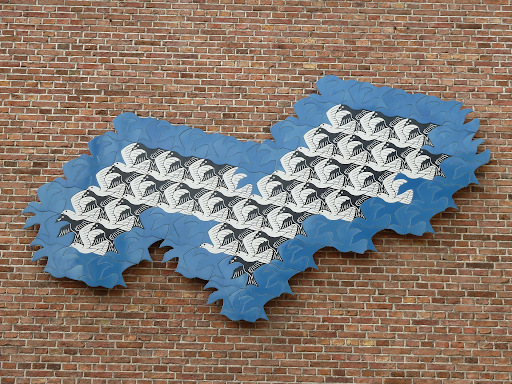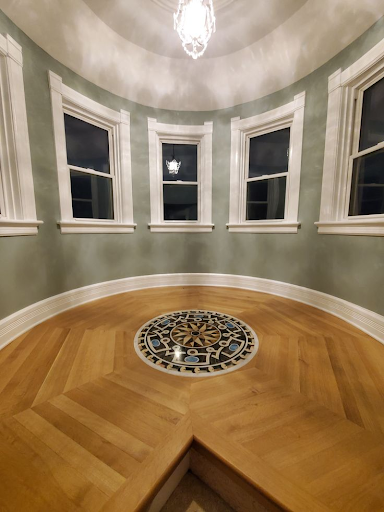You may be looking at a tessellated pattern right now, and not realize it! Although it’s not a term you hear every day, tessellation is a key component of art and decoration. Simply defined, it’s a repeated geometric shape that covers a surface. The name comes from something we hold dear here at Mozaico: Tessera – or the small tiles used in mosaic work.

Here’s another word you can now use to impress your friends, and to win at Scrabble: Tessellata. Thank the ancient Romans for this one – it refers to the mosaic that decorated their buildings, and that still delights us today in historical locations.
Designers love tessellation – it’s present on all types of home decor, like wallpaper, fabric, quilts, and rugs. These patterns are soothing and full of movement – endlessly versatile in their uses of different shapes and colorways. We’ll give you a little background on the history of this concept in art and design, and some ideas on how you can use it in your own home.
Islamic Art and Tessellation
Historically, Islamic art and architecture utilized tessellation in their religious architecture. As they shied away from the use of human or animal figures, intricate geometries were used as decoration. The Dome of the Rock, in Jerusalem, is a notable location for this style.

The mathematical precision and evolving patterns of these embellishments were also designed to help the faithful focus on their worship. During Islam’s Golden Age of the 8th – 14th century CE, Muslims created a distinctive style. It relied heavily on mathematics, with contributions from the best astronomers and scientists contributing ideas, as well. Precise calculations created perfect stars, circles, and polygons. As each overlapped, an intricate network of shapes emerged, delighting the eye and fascinating visitors. In this example from the Tomb of I’timād-ud-Daulah, in Agra, one can see several different shapes that are used in repetition. Five and 6-point stars, circles, and other strict geometrics will appear as you study the decoration.

A Few Definitions
The language of tessellation is also precise in nature. If you’re digging into the subject, you might want to learn a few of the terms that are used.
Regular tessellation uses only equilateral triangles, squares, and hexagons. Fun fact: Any one of these shapes can be duplicated infinitely to fill a plane with no gaps.
Regular periodic tiling is a cornerstone of patterns such as checkerboards. Each tile aligns vertex to vertex (the point of intersection of three or more bordering tiles) and repeats. Often, a contrasting color is used for maximum effect – yes, like a checkerboard!
Irregular tessellations can be made from other shapes such as pentagons. In fact, almost any kind of geometric shape can work. The example below is from the Alhambra in Spain. If something about these glazed mosaic tiles from centuries ago seems familiar, even modern – you’re not imagining it.

Part of a group of patterned tile installations that contain nearly all, if not all, of the seventeen mathematically possible wallpaper groups, it’s world-famous. (If you’re curious about the 17 ways to tile a surface, here’s an illustration from 1924).

Escher and the Art of Tessellation
Back in 1922, artist M. C. Escher’s visit to the Alhambra inspired his studies of Moorish design symmetries, and eventually, his own works. Escher called these “regular divisions of the plane”.
Here’s Escher’s piece: Hexagonal tessellation with animals: Study of Regular Division of the Plane with Reptiles (1939). You can definitely see the influence.

Escher went on to explore the mathematical qualities of these shapes in sculpture and other media. His work lends itself well to tile designs and mosaic art, as in this piece at the Princessehof Ceramics Museum.

Warm and Cuddly Tesseration? Sure!
Another type of art that has embraced tessellation is quilting. You might not think of math, geometry, and your favorite quilt as compatible, but they’re fantastic together! Many popular patterns are fine examples of repeated shapes.

Now that you know what to look for, can you pick out the shapes that are used in this design?
Here’s another vintage example that uses one long hexagon shape for each section:

Up Against the Walls
How about wallcoverings? Let’s test your discerning eye out with some Islamic patterns for wallpaper. One block – or tile – is used over and over to create the unique look. It looks organic, but the same concept applies.

William Morris patterns for textiles and wallpaper also employ tessellation. Just like the patterns used in Islamic temples, they have a soothing effect that also invites closer investigation.

Here’s a similar design in glass mosaic wall art.

Modern Uses – Step Up!
Today, some of the loveliest examples of tessellation are right underfoot! Rugs, both textile and mosaic, are perfect for these step-and-repeat patterns. Our own marble mosaic design features spheres in a soft color range of whites with black. Just like the works we’ve been studying, there’s more than meets the eye – with thousands of geometric tessera making up the overall design.
A stunning centerpiece for any room, our classical Falak round marble mosaic art piece will give any space an instant lift. The opulent feel is created with multicolored stones. One of the best features of this type of floor art is its versatility: it can be used on surfaces that are exposed to moisture, such as showers or pools.
Does your floor need a spectacular focal point? Here’s a beautiful example of our stunning Galileo Waterjet Marble Mosaic Artwork installed. Made of polished marble, it’s a heavenly design that draws you in with intricate patterns and fine details.

As you can see, tessellation is everywhere! Have some fun appreciating its intricacies and beauty, and enjoy your new awareness. If you’d like to add this sort of stylish detail to your own space, check out our new Mosaic Finder. It’s a fun way to explore our extensive catalog and find the perfect mosaic art for any spot in your home.


3 comments
Thank you for your insightful comment! You’re absolutely right—the historical intersection of the golden age of Islam and the Byzantine Empire is a fascinating topic, with deep cultural and artistic implications. Including sacred artwork from this period could indeed provide a richer understanding of the era’s cultural and religious dynamics. We appreciate your suggestion and will consider incorporating more diverse visual elements in future articles to enhance our content. Thanks again for your valuable input! And we hope everyone enjoys their mosaic art ❤️
The golden age of islam coincided with the conquoring of nearly a third of Roum Orthodox (Roman Orthodox), or what was later called “Byzantine” by 15th C German historians. The roots of this in pagan romanity continued with the Christianization of the longest empire in history, Orthodox Christian Rome. This article could be improved by also displaying this sacred artwork.
Definitely adding a tessellation pattern mosaic in my space